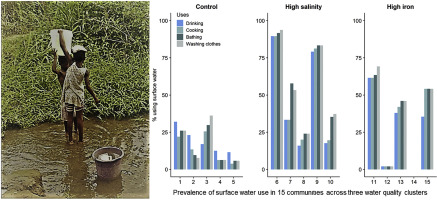International Journal of Hygiene and Environmental Health ( IF 6 ) Pub Date : 2020-04-02 , DOI: 10.1016/j.ijheh.2020.113514 Alexandra V Kulinkina 1 , Michelle O Sodipo 2 , Olivia L Schultes 2 , Bernard G Osei 3 , Emmanuel A Agyapong 3 , Andrey I Egorov 4 , Elena N Naumova 1 , Karen C Kosinski 2

|
Sustainable Development Goal (SDG) 6 aims to achieve universal access to safe drinking water sources. However, the health benefits of meeting this goal will only be fully realized if improved sources are used to the exclusion of unimproved sources. Very little is known about how rural African households balance the use of improved and unimproved water sources when multiple options are present. We assessed parallel use of untreated surface water and unimproved hand-dug wells (HDWs) in the presence of boreholes (BHs) using a semi-quantitative water use survey among 750 residents of 15 rural Ghanaian communities, distributed across three BH water quality clusters: control, high salinity, and high iron. Multivariate mixed effects logistic regression models were used to assess the impact of water quality cluster on the use of BHs, HDWs, and surface water, controlling for distance to the nearest source of each type. Reported surface water use was significantly higher in the high salinity and high iron clusters than in the control cluster, especially for water-intensive activities. Respondents in the non-control clusters had approximately eight times higher odds of clothes washing with surface water (p < 0.01) than in the control. Respondents in the high salinity cluster also had 4.3 times higher odds of drinking surface water (p < 0.05). BH use was high in all clusters, but decreased substantially when distance to the nearest BH exceeded 300 m (OR = 0.17–0.25, p < 0.001). Water use from all sources was inversely correlated with distance, with the largest effect observed on HDW use in multivariate models (OR = 0.02, p < 0.001). Surface water and HDW use will likely continue despite the presence of BHs when perceived groundwater quality is poor and other water sources are in close proximity. It is essential to account for naturally-occurring but undesirable groundwater quality parameters in rural water planning to ensure that SDG 6 is met and health benefits are realized.
中文翻译:

当井眼出水具有不良的感官特性时,加纳农村家庭更可能使用未经改善的替代水源。
可持续发展目标(SDG)6旨在实现普遍获得安全饮用水来源。但是,只有使用改进的来源排除未改进的来源,才能完全实现实现此目标的健康益处。当存在多种选择时,对非洲农村家庭如何平衡使用改良和未改良水源的了解甚少。我们使用半定量用水调查,对分布在三个BH水质集群中的15个加纳农村社区的750名居民进行了半定量用水调查,评估了在存在钻孔(BH)的情况下对未经处理的地表水和未经改善的手挖井(HDW)的并行使用情况:控制,高盐度和高铁。多变量混合效应逻辑回归模型用于评估水质集群对BH,HDW,和地表水,控制到每种类型的最近水源的距离。据报道,在高盐度和高铁集群中,地表水的使用量明显高于对照集群,特别是在水密集型活动中。在非对照组中,被调查者用地表水洗衣服的几率大约是对照组的八倍(p <0.01)。高盐度集群中的受访者饮用地表水的几率也高4.3倍(p <0.05)。在所有集群中,BH的使用都很高,但是到最近的BH的距离超过300 m时,BH的使用显着下降(OR = 0.17–0.25,p <0.001)。所有来源的用水量与距离成反比,在多变量模型中观察到的对HDW使用的最大影响(OR = 0.02,p <0.001)。尽管存在BH,但当地下水质量差且其他水源非常接近时,尽管存在BH,地表水和HDW的使用仍可能继续。在农村水务规划中,必须考虑自然产生但不受欢迎的地下水质量参数,以确保达到SDG 6并实现健康效益。


























 京公网安备 11010802027423号
京公网安备 11010802027423号